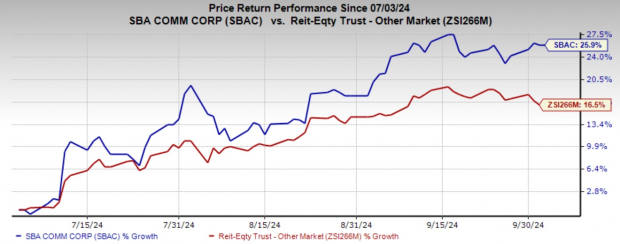SBA Communications' SBAC extensive and geographically diverse wireless communication infrastructure portfolio is well-positioned to gain from the wireless carriers' high capital spending for network expansion amid growth in mobile data usage and accelerated 5G network deployment efforts.
The long-term leases with its tenants assure stable revenues. Also, portfolio expansion moves, domestically and internationally, to capitalize on the secular trends of the industry are encouraging.
However, customer concentration and consolidation in the wireless industry are key near-term concerns. The churn arising from the Sprint-related decommissioning is likely to hurt top-line growth.
Shares of this Zacks Rank #3 (Hold) company have risen 25.9% over the past three months, outperforming the industry's upside of 16.5%.

Image Source: Zacks Investment Research
What's Aiding SBAC?
The advancement in mobile technology, such as 4G and 5G networks, and the proliferation of bandwidth-intensive applications have propelled growth in mobile data usage globally. This has resulted in wireless service providers and carriers expanding their networks and deploying additional equipment for existing networks to boost network coverage and capacity to meet the rising consumer demand, poising tower real estate investment trusts like SBAC well for growth.
SBA Communications has a resilient and stable site-leasing business model. The company generates most of its revenues from long-term (typically five to 10 years) tower leases that have built-in rent escalators. With high operating margins, its tower-leasing business remains attractive.
As the company continues to expand its tower portfolio and seek new growth opportunities, it focuses on business expansion into domestic and select international markets with high growth characteristics. During the first half of 2024, SBAC acquired 128 towers and related assets. In the second quarter of 2024, it also built 100 towers. Subsequent to June 30, 2024, the company purchased or is under contract to purchase 106 communication sites for a total cash consideration of $49.3 million. Such portfolio expansion efforts will position SBA Communications to leverage secular trends in mobile data usage and wireless spending growth across the globe.
Solid dividend payouts are arguably the biggest enticement for investment in REIT stocks. SBAC has increased its dividend five times in the last five years, and its five-year annualized dividend growth rate is 22.42%. Given SBA Communications' decent financial position and lower-than-industry dividend payout rate, the dividend distribution is expected to be sustainable over the long run.
What's Hurting SBAC?
The company has a high customer concentration, with T-Mobile TMUS, AT&T T and Verizon VZ accounting for the majority of its domestic site-leasing revenues. In the second quarter of 2024, T-Mobile, AT&T and Verizon accounted for 38.2%, 29.7% and 20.2%, respectively, of SBAC's domestic site-leasing revenues.
The loss of any of these customers, consolidation among them or a reduction in network spending might hurt the company's top line significantly. The churn arising from the Sprint-related decommissioning is likely to weigh on its performance in the near term.
SBA Communications has a substantially leveraged balance sheet, with $12.4 billion of total debt and net debt to the annualized adjusted EBITDA leverage of 6.4X as of the end of the second quarter of 2024. The high amount of debt is likely to keep SBA Communications' financial obligations elevated. Moreover, its debt-to-capital ratio is higher than the industry average. A high debt-to-capital ratio limits its strength to withstand any credit crisis and unexpected negative externalities in the future.
Note: Anything related to earnings presented in this write-up represents funds from operations (FFO), a widely used metric to gauge the performance of REITs.
© 2024 Benzinga.com. Benzinga does not provide investment advice. All rights reserved.








